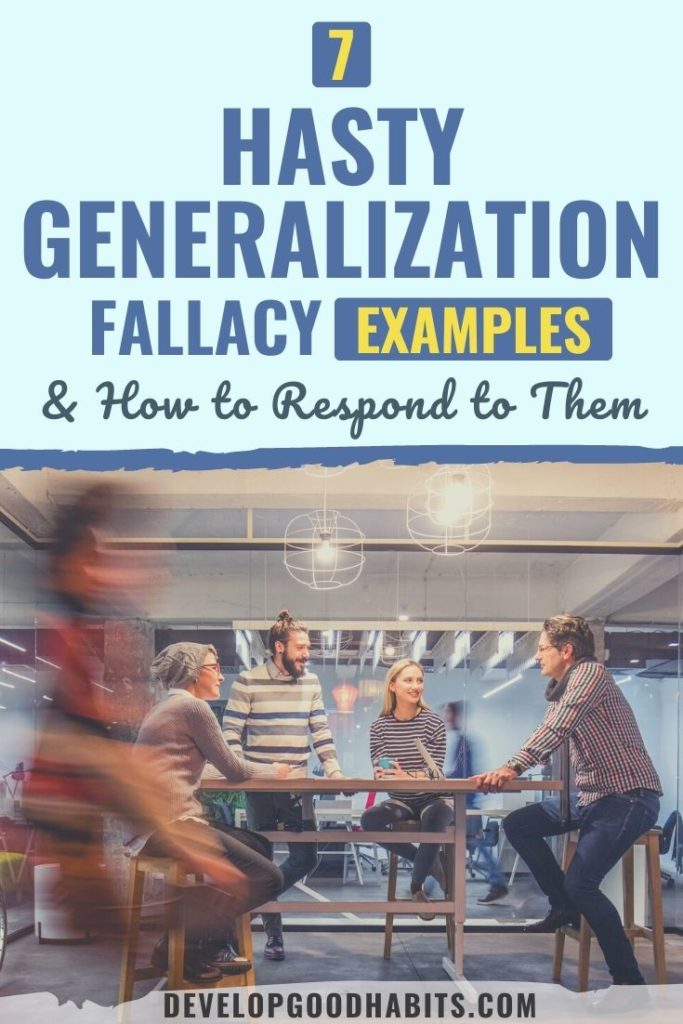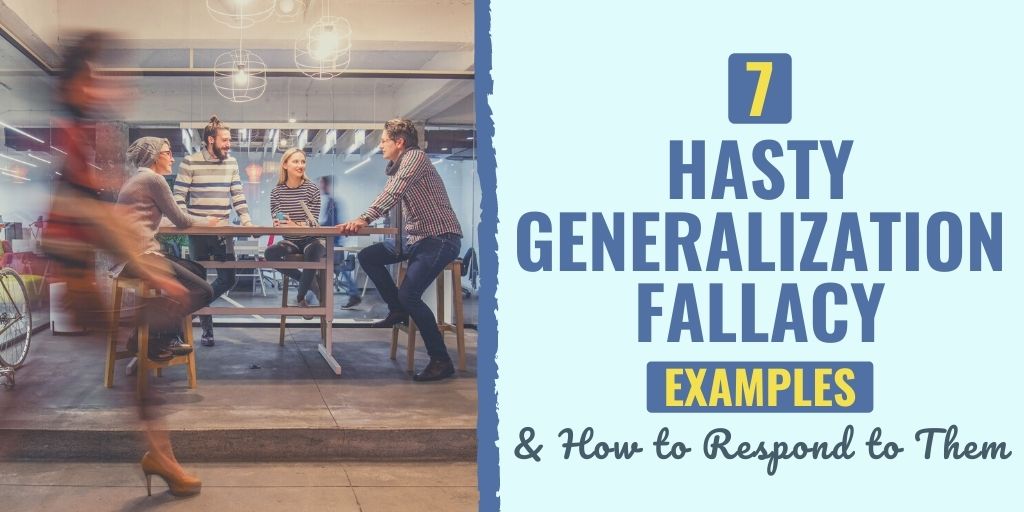There might be affiliate links on this page, which means we get a small commission of anything you buy. As an Amazon Associate we earn from qualifying purchases. Please do your own research before making any online purchase.
When in his 80s, a friend’s grandfather (Pappy) told me that he’s smoked a pack of cigarettes a day since he was a teenager and he turned out just fine, so it can’t really be that bad for you.
Now, for any of you who can think back to statistics 101, n=1 in Pappy’s little assessment there.
And according to actual statistics, sweet Pappy should have been dead before he even turned 69.
Just like a logical fallacy, a hasty generalization is an error in reasoning, and it’s unfortunately common. The main reason why people make hasty generalizations is because our brains rely on shortcuts (which are referred to as heuristics), to speed up our sense of judgment and decision-making processes–however, this happens at the expense of reducing the accuracy of our judgments and the excellence in our decisions.
In some cases, people misuse heuristics, causing them to take extreme mental shortcuts that are inaccurate. Because of this, hasty generalizations are the source of many erroneous and misguided stereotypes and assumptions.
It’s easy to resort to this type of reasoning, but it’s important to catch yourself before really trying to convince someone (or yourself) that something is true. Being mindful of how hasty generalizations are committed will help us recognize when we (or other people) violate the fundamentals of sound reasoning.
What is a Hasty Generalization?
A hasty generalization is an illustration of jumping to conclusions. It’s when a judgment is made about every instance of a particular circumstance based on only one or two past episodes of the event or phenomenon. When one makes a hasty generalization, they apply a superficial belief to a larger population based on the negligible information that they have.
A hasty generalization typically looks like this:
- A is true for B.
- A is true for C.
- Therefore, A is true for D, E, F, G, etc.
Let’s look at some examples of hasty generalizations that you may recognize and then explore how the arguments can be countered.
7 Hasty Generalization Fallacy Examples & How to Respond to Them
1. Social Media
As you scroll through your social media feed, you’re probably met with smiling faces of friends (and friends of friends) who appear to be living the dream life. Picture after picture shows people at events, out with friends, and on vacations with their beautiful families.
However, your sample size of their current situation in life is microscopic–just one instant out of millions. This isn’t even close to enough evidence to prove that someone else is happy, free from struggles, or has everything they need in life. The carefully thought-out pictures that your friends post on social media likely aren’t an accurate representation of their everyday life.
Example: You get on social media and see a picture posted of two of your friends having a night out together, smiling for the camera. You immediately feel jealous because, by looking at the picture, you believe that they are both living carefree lives and have enough free time (and money) to go out all the time and have fun. Also, why weren’t you invited?
How to Respond: Turn down the FOMO for a second andthink for a second about what you post on social media. Or, actually, go scroll through your posts. Have you posted any pictures of yourself sitting home alone in your pajamas lately looking sad and worrying about…money/work/family/health/the world…
People use social media to curate the best images of themselves to show off to their friends, family…enemies, ex-partners, etc. That’s actually pretty much the point of posting on social media. If you feel a bit down about yourself as you’re scrolling through your feed, you’re not alone, as studies have shown this is a common internal reaction to seeing pictures of other people living their unique lives.
Recognize you’re making a hasty generalization because you can’t assume anything about a person’s life simply by looking at one picture. If you need proof, one Twitter user posted the following:
“im curious. if youre comfortable doing so, post a picture of you that you shared on social media where you were actually having a really tough time in life even tho you look perfectly fine in the picture.” [sic]
This got a massive response within minutes as people reposted pictures of themselves and gave a short description of what was going on behind the camera–which was never a sense of joy.
2. Teenagers.
Do you feel a certain way just by reading the word?
Teenagers get a bad rap. From their sense of entitlement to their addiction to technology and materialistic tendencies, no wonder people talk about the “impending Armageddon” that’s waiting for us on the horizon as future generations start to take over the nation.
The issue here though is more about how teenagers are perceived. But where are we getting our data? Movies, television, the extreme cases when a violent teenager makes national news…
The most accessible information about young people is through the media, which doesn’t portray them well. We live in a media-saturated society, and apparently, watching well-behaved teenagers on television is “boring”. However, this representation is a huge distortion of the reality of the entire population of teenagers. That’s not to say there aren’t any teens who could use some straightening up, however, for every “bad” teen one person can come up with, another person can fire back with a teenager who has made it into the New York Times this month.
Example: “Oh, you have an 8 year old? Just wait until they’re a teen!”
How to Respond: Yes, these statements usually come with good intentions, which is likely to commiserate over the difficulties of parenting. However, such a statement is also making a hasty generalization that your child will be among the few teens who actually live up to their reputation.
Because this is such a personal example, you may have to tailor your response to the person who is saying it if you find yourself in this situation, but a polite way to point out that not all teens are awful would be to say, “She has so much ahead of her and her possibilities are endless.”
This will at least show that you don’t buy into the idea that you’re destined to be heading for disaster.
3. Living “Off of the Government”
I have heard a lot of people throughout my life voice concerns about citizens who “live off of the government”. Many assume that those who receive government assistance are lazy and are allowed to lay around the house all day while receiving money at taxpayers’ expense.

Government assistance programs aren’t designed to encourage people to be lazy for the rest of their lives.
This assumption may be just that (an assumption) or it could be made after witnessing a situation where this is the attitude of someone who receives some type of welfare. However, applying that mindset to everyone receiving government assistance is a hasty generalization. The truth is, the amount of money that people receive through any welfare program doesn’t provide for a lavish lifestyle. It can cover a family’s basic needs, but that doesn’t mean they’re “getting off easy” by “sitting around” all day.
In fact, I’m sure you’ve heard of food stamps–which is now known as the Supplemental Nutrition Assistance Program (SNAP). The average amount of money that recipients receive from this program is $1.39 per meal, which is hardly enough to feed yourself–not to mention feeding yourself with healthy food. Government assistance programs aren’t designed to encourage people to live off of them for the rest of their lives, and many come with time limits.
Example: After receiving a paycheck and seeing the amount of taxes taken out on the attached pay stub, a co-worker says, “I hate having to pay lazy people to sit around at home.”
How to Respond: A lot of people who complain about having to pay toward welfare actually receive it themselves in one way or another without realizing it, because they aren’t educated about what welfare actually entails.
In fact, professionals on the subject have discovered that on average, Americans in the highest income bracket and those in the lowest income bracket have used the same total number of benefits. They use different types of policies, with some being more visible (like TANF) and others being more submerged (like a home mortgage interest deduction), but we are all benefitting from the government’s help in some way. The only way to get people to stop spreading misinformation about taxes and welfare programs is to educate them.
Furthermore, most government assistance programs require recipients to be employed in order to collect funds. For example, single parents receiving Temporary Assistance for Needy Families (TANF) have to work at least 30 hours each week to qualify for this program, and two-parent families have to work a total of 35-50 hours per week.
A lot of jobs in our country pay wages that just aren’t high enough to support people living in today’s economy. In fact, the wages that many large employers pay their workers are so low that even those who work full time are eligible to receive money from programs that people simply refer to as “welfare”.
So, people who work just as hard as your protesting co-worker to support their families–who also pay taxes–are often the recipients of these government assistance programs.
And, when it comes to SNAP benefits, let’s not forget that half of the recipients of these funds are children. Over 82% of all food stamp money goes to households with children, elderly people, or those suffering from disabilities. These are people who are living at the mercy of these programs.
So where are all the able-bodied (yet lazy) adults who are revelling off of your co-worker’s paycheck? It’s a hasty generalization to assume they actually exist.
4. Stereotyping
Picture yourself for a moment rushing through the grocery store to grab a few quick things on the way home after a long day. At checkout, you see one lane with an elderly customer in line, and another lane with two young-looking professionals waiting for their turn. Which line would you choose?
While you may claim (and even may truly believe) that you don’t stereotype others based upon their race, age, sexual identity, or any other factors, implicit biases (also known as unconscious biases) are simply a fact of life. These social stereotypes are formed by individuals–even if they go unrecognized–and pertain to certain groups of people.
Everyone has their own implicit biases about various groups of people, which is due to our tendency to categorize and organize people into various social worlds. Having unconscious bias is far more commonplace than having conscious prejudices, and these biases frequently don’t align with one’s actual values. But the truth is, stereotyping can be very detrimental.
A lot of stereotypes are negative, such as assuming people of a certain demographic are lazy, immoral, or uneducated. Others may seem positive, like assuming some people are extremely smart or athletic. And others are neutral, like making an assumption that someone eats certain types of food. However, all of them are harmful.
The truth about stereotypes is that they contribute to a flawed system. Stereotypes that are either negative or seemingly positive keep minority groups at a disadvantage. Negative stereotypes are obviously harmful because making assumptions instead of gathering personalized information can lead to the denial of employment, housing, and other opportunities that people need access to. And “positive” stereotypes can also be detrimental–think of children who are persuaded against going to college in favor of pursuing a professional athletic career due to their demographic. The vast majority of people entering this profession are destined for failure.

Negative stereotypes are harmful because they make assumptions instead of gathering personalized information.
It takes many repeated experiences to challenge a stereotype, but the first step is to be able to identify it and be more intentional about getting to know people who come from different backgrounds. When we start interacting with those who are different from us, our biases are challenged repeatedly, making it more difficult to come to these conclusions in the future.
Example: You’re having lunch with colleagues when someone makes a joke that points out a racial stereotype.
How to Respond: “What do you mean by that?”
Asking a question places a burden on the other person, as they’re now faced with having to explain their “joke” or outwardly support a stereotype (rather than suggesting it through a joke). This often puts the person at a loss, which can help them gain a deeper understanding of why their hasty generalization in this case is offensive.
5. Dogs
Pit bulls are known to be aggressive. And, along with other animals, there are certainly instances in which this is true. However, many people assume all pit bulls are dangerous because they’ve read about this type of dog attacking another dog or maybe they’ve even witnessed this happening themselves.
However, this is a hasty generalization, as not all pit bulls are inherently dangerous. It’s easy to forget that dogs are animals, and like any other dog, pit bulls can become violent and aggressive due to a lack of training or irresponsible ownership.
Example: “I don’t want to go to my friend’s house because they just adopted a pit bull and I don’t want to get attacked.”
How to Respond: If you want to defend this dog breed to people who misunderstand them, remind them that properly trained pit bulls who are treated with respect are actually very loving dogs. In fact, according to the American Temperament Test Society, pit bulls have a 82.9% temperament passing rate (which is relatively high). This scale measures each dog’s ability to interact with people, human situations, and their surrounding environment.
So, if you hear someone saying they don’t want to be around a pit bull, ask them if they know and trust the dog’s owner and advise them that in this case of “nature vs. nurture”, nurture is going to be the primary factor in the dog’s behavior.
6. Advertisements
We’ve all seen advertisements for products that rely on success stories to make a profit. This is especially true in ads for weight loss products, as they frequently portray a happy, thin person who is displaying a “before” picture for the viewers while saying, “If I can do it, you can, too!”
These ads are convincing because they show an “everyday person” who has been able to turn their life around due to whatever product they’re trying to sell. And, as viewers watch these people enjoying their huge success (often after having to do little or no actual work to get to where they are now), they want to jump on that bandwagon!
Example: You see a success story ad on television featuring a person who appears to be happy wearing an old pair of pants that could now fit an additional human inside them. They’re telling viewers that they lost 60 pounds in 3 months without changing their diet or exercise–just by taking this pill three times a day, “and so can you!”
How to Respond: Look at the bottom of the screen–you’ll likely notice an asterisk with some small writing next to it, which says: “Results not typical.”
Look at the real research behind the product to see what the average results are. Also, remember, if there were a quick fix to losing weight, no one would be overweight. And someone–whoever discovered the trick–would be extremely rich.
7. Anecdotal Evidence
Hasty generalizations can happen when someone is using examples from their own experiences rather than from actual statistical or scientific evidence to try to prove a point. People rely on their past experiences to make decisions in the future, so this makes sense, but it doesn’t create a universal truth.
Example: Let’s say someone experienced a rare–albeit extreme–side effect to a prescription medication, leading them to advise other people to not take this medicine.
How to Respond: While you don’t want to discount this person’s experience, the medicine has probably helped thousands of other people in the past (or else it wouldn’t still be on the market). Personal examples are naturally very compelling because the person telling the story is generally vehement about their opinion, however, they’re unreliable.
Show empathy for their past ordeal by telling them you can’t imagine how awful it must have been to experience such a bad reaction to the medication–and leave it at that. Unfortunately, in this type of situation, you won’t change the other person’s mind (and you both know that they aren’t going to use the medicine again) but you also don’t need to remind them of how it could benefit you.
Learn More About Logical Fallacies
- 5 Appeal to Nature Fallacy Examples in Media and Life
- 6 Outcome Bias Examples That Can Negatively Impact Your Decisions
- 7 Self-Serving Bias Examples You See Throughout Life
- 7 Omission Bias Examples That Negatively Impact Your Life
- 6 Authority Bias Examples That Might Impact Your Decisions
- 5 Burden of Proof Fallacy Examples
- 5 Appeal to Tradition Fallacy Examples in Life
- 5 Appeal to Authority Logical Fallacy Examples
- 7 False Cause Fallacy Examples
- 7 Appeal to Ignorance Fallacy Examples
- 7 Appeal to Common Sense Logical Fallacy Examples
- 5 Post Hoc Fallacy Examples (and How to Respond to This Argument)
- Gambler’s Fallacy: 5 Examples and How to Avoid It
- 5 Appeal to Anger Fallacy Examples Throughout Life
- 7 Halo Effect Bias Examples in Your Daily Life
- 7 Poisoning the Well Examples Throughout Your Life
- 7 Survivorship Bias Examples You See in the Real World
- 7 Dunning Kruger Effect Examples in Your Life
- 7 Either Or (“False Dilemma”) Fallacy Examples in Real Life
- 5 Cui Bono Fallacy Examples to Find Out “Who Will Benefit”
- 6 Anchoring Bias Examples That Impact Your Decisions
- 7 Virtue Signaling Examples in Everyday Life
- 7 Cherry Picking Fallacy Examples for When People Ignore Evidence
- 9 Circular Reasoning Examples (or “Begging the Question”) in Everyday Life
- 9 Appeal to Emotion Logical Fallacy Examples
- 9 Appeal to Pity Fallacy (“Ad Misericordiam”) Examples in Everyday Life
- 9 Loaded Question Fallacy Examples in Life and Media
- 9 Confirmation Bias Fallacy Examples In Everyday Life
- 9 Bandwagon Fallacy Examples to Prevent Poor Decisions
- 5 Red Herring Fallacy Examples to Fight Irrelevant Information
- 9 Middle Ground Fallacy Examples to Spot During an Argument
- 5 False Equivalence Examples to Know Before Your Next Argument
- 6 Straw Man Fallacy Examples & How You Can Respond
- 6 False Dichotomy Examples & How to Counter Them
- 7 Slippery Slope Fallacy Examples (And How to Counter Them)
- What is the Planning Fallacy?
- How to Overcome the “Sunk Cost Fallacy” Mindset
Final Thoughts on Hasty Generalizations
The best way to avoid making or believing a hasty generalization is to stop, analyze the information, and consider your source. To find anything that is close to an actual truth, look for evidence that both supports and opposes a claim and make your best judgment from there. Avoid coming to a conclusion about anything if you have insufficient data.
Once a hasty generalization is made, our confirmation bias kicks into gear, strengthening our beliefs with every instance we encounter. This can lead to deep convictions and a loss of the ability to take an impartial look at any evidence suggesting otherwise. Unfortunately there always seems to be a lot of “exceptions to the rule”, and counterexamples may not be so readily available, however, this doesn’t make a hasty generalization correct. One person's experience isn’t enough to determine the experience of an entire group.
Finally, if you want a simple process to counter the logical fallacies and cognitive biases you encounter in life, then follow this 7-step process to develop the critical thinking skills habit.

Connie Mathers is a professional editor and freelance writer. She holds a Bachelor's Degree in Marketing and a Master’s Degree in Social Work. When she is not writing, Connie is either spending time with her daughter and two dogs, running, or working at her full-time job as a social worker in Richmond, VA.


